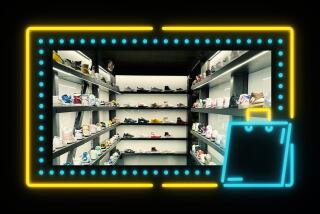Museum Offers Sentimental Memories of Red-Light Landmark
WALLACE, Idaho — For life is not the thing we thought,
and not the thing we plan.
And woman in a bitter world,
must do the best she can.
--”The Harpy,” by Robert Service
The girls upstairs in the Oasis Rooms still dress like hookers, and it costs $4 to see them.
These days, though, customers can look but they can’t touch. The girls are mannequins and the former bordello is a museum.
Midday at the Oasis, tourists roam the halls.
It’s a strange kind of tourist trap, combining a cartoon version of sexuality with Wallace’s long history as the sin capital of the Inland Northwest.
“It’s a fine line between making it interesting and not being offensive,” said owner Jack Mayfield, retired from the nearby Lucky Friday silver mine. “You see more [sexuality] on TV than you do up here.”
The museum opened in 1993 and immediately caught people’s attention.
“I got a call from a prostitute who wanted her old job back,” recalled Michelle Mayfield, Jack’s wife. “I told her we don’t do that in Wallace anymore.
“She says, ‘How can you make a museum out of a whorehouse?’ ”
Well, the Mayfields bought a former house of ill repute whose interior was left intact after it closed in 1988. They added a little history, some folklore and sentimental memories from those proverbial hookers with hearts of gold.
The original Oasis opened in 1895--museum receipts mention “A Century of Service.” It was one of five bordellos that operated along Cedar Street, the red-light district of this mining town 70 miles east of Spokane, Wash.
“There were so many men and so few women,” Michelle Mayfield said. “Almost any two-story building with a bed was used sooner or later as a bordello.”
Prostitution was outlawed in 1973, but the houses remained open. When the Oasis was raided by law officers for the umpteenth and last time in 1988, the working girls grabbed their purses and little else, Mayfield said.
The house never reopened--leaving a sort of still-life rendering of the world’s oldest profession, circa 1980s.
The first floor, which serves as the museum gift shop, offers a glimpse of 19th century prostitutes--the “soiled doves” who were often the only women in boom towns. Visitors can leaf through a biography of 19th century hooker Molly b’Dam, who tended the sick before dying at age 35 in nearby Murray in 1888.
The shop is decorated with gaudy red wallpaper, red velvet furniture and a piano. Its wares include glow-in-the-dark panties, double-entendre T-shirts and, for $32.95, a commemorative silver coin depicting Ginger, the “Last Madam of the Oasis Bordello.”
Near the front of the gift shop are steep, narrow stairs to the second floor. It costs $4 to pass through the door with its nine locks and into the dingy, wood-paneled bordello.
“It’s changed since I was last here,” said one visitor, drawing laughter from the others.
Bordello customers were taken to one of three waiting rooms, where they would be visited by a number of scantily clad ladies, tour guide Michelle Mayfield said.
After the customer made his choice, he’d be led down the hall to the prostitute’s tiny room for a few minutes of business.
According to a price list posted on the wall of the madam’s room, it cost $15 for eight minutes of sex, a standard time limit in the business, Mayfield said. A “half-and-half deluxe” cost $25, while “Straight French” was $30. She didn’t explain the terms.
For $50, clients could spend half an hour with their selection and take a bubble bath with her.
“They used a lot of Mr. Bubble,” Mayfield noted.
The tiny bedrooms, furnished with a twin bed, dresser and makeup table, had no locks. Each room was connected by intercom to the madam’s room, so she could monitor activity.
Much of the information on the tour was provided by former prostitutes who came for a visit, Mayfield said.
The lone bathroom, on the second floor, is still stocked with toiletries, including powder to kill lice.
Business transactions were logged in the kitchen-dining area. Each prostitute was assigned a wooden box, where she deposited her earnings between customers. There’s an egg timer atop each box.
When the timer rang, the madam would knock on the woman’s door, signaling the customer that his time was up, Mayfield said.
The cut was 40% for the prostitute and 60% for the house. During good times in the final years, women could earn up to $2,000 per week, although the take could also be just a few hundred dollars.
Although prostitution was outlawed in 1973, Wallace authorities winked at it for the next decade.
The business was built into the local economy. Before prostitution was criminalized, the city assessed each house $150 per month to pay for municipal services. The prostitutes also bought band uniforms for Wallace High School in the 1950s and a new police car for the city in 1982, Mayfield said.
Anne Seagraves, author of “Soiled Doves, Prostitution in the Early West,” said the museum accurately recalls a time when prostitution was accepted as a part of life on the frontier.
“They were surrogate mothers and sisters,” said Seagraves, who lives in nearby Hayden, Idaho, and published her book herself. “They took care of the men when they were sick.”
But the days when gambling and prostitution were bedrock industries here are long gone, Jack Mayfield said.
“There is no illegal gambling or whorehouses left,” he said.
More to Read
Sign up for The Wild
We’ll help you find the best places to hike, bike and run, as well as the perfect silent spots for meditation and yoga.
You may occasionally receive promotional content from the Los Angeles Times.






